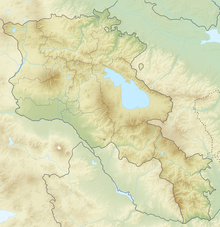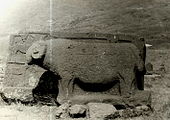Vorotan (Sjunik)
Vorotan ( Armenian Որոտան ), other romanization Vorotan , until 1968 Urud , is a village and a rural community ( hamaynkner ) in the southern Armenian province of Sjunik near Sissian . There was a medieval Muslim cemetery in the place until its destruction in the 1980s. The gravestones were important because of their figural reliefs dating back to pre-Islamic times.
location
Coordinates: 39 ° 29 ′ 19 ″ N , 46 ° 8 ′ 29 ″ E
Worotan is located at 1,433 meters above sea level in the valley of the river of the same name about 14 kilometers southeast of the provincial capital Sissian. The high, grass-covered hills in the area are jagged by side valleys. They serve as pastureland. Craggy basalt rocks emerge on the slopes , which in some places form vertical edges formed by basalt columns.
The Vorotan flows from Sissian in a south-easterly direction in a deep valley that narrows to a gorge with steep rock walls at the Vorotnavank monastery , two kilometers before the village of Vorotan. South of the monastery, the valley widens and offers space for small parceled vegetable fields on the bank. Shortly before the road reaches a bridge over the river about a kilometer after Vorotnavank, a road branches off to the east, which continues on the left bank for almost a kilometer to the village. The main road runs parallel on the right bank of the river and bypasses the hill of Vorotnaberd , the fortress of the military leader David Bek († 1728), on its western flank. From the south, the place hidden on the east side of the fortress hill can be reached by another roadway that crosses the river at a bridge built in 1855.
Townscape
In the 2001 census, the official population was 283. In January 2009, according to official statistics, Vorotan had 302 inhabitants.
The predominantly single-storey small farmhouses, some two-storey longer houses with wooden facades and cattle stalls are scattered across the valley between trees on the eastern bank of the river. Only Azeris lived here until they were expelled from 1988 and finally by the war for the Nagorno-Karabakh region in the early 1990s, making way for Armenians who came as refugees from Azerbaijan. Cattle and sheep breeding continue to form the basis of income from agriculture in addition to modest farming.
The half-finished ruin of a spa remains from the Soviet era , which could not be completed due to lack of money. There is a pool with warm water below the fortress hill and 100 meters north of the bridge. However, the thermal water springs of Shamb with a swimming pond a few kilometers south are better known.
The only large solid building in Vorotan is the school. The bridge made of roughly hewn basalt stones, which spans the river with a pointed arch, was commissioned by Melik Tangi, a nobleman from Brnakot, west of Sissian.
Muslim cemetery
Urud was the former Azerbaijani place name in the historical region of Sangesur . The medieval Muslim cemetery of Urud is of cultural and historical importance, as it contained tombstones with an unusually large number of figural reliefs until it was destroyed. A tombstone with the outer shape of a ram is decorated on one side with a lively scene of horsemen and people walking. In 1927, the Russian art historian V. Sysoyev reported on a large cemetery in Urud with tombstones, many of which represented sheep and which were venerated by the local population. Most of the tombstones, which also show hunting scenes, everyday life and mythical figures, date from the 15th to 17th centuries.
Zoomorphic tombstones, which depict sheep and horses and can almost reach life size, are common in the southern Caucasus region , in eastern Turkey and as far as the Iranian province of Azerbaijan . They are a sign of the cultural influence of the Turkic people who immigrated from North Asia . Even after the Islamization of the region began in the 8th century, North Asian beliefs remained in the popular beliefs of many Muslims as well as Armenian Christians. In the Yazidi village of Alagyaz in the north of the country, tombstones with horses and sheep are in the open field.
Arabic inscriptions on the tombstones refer to certain spiritual beings ( ongun, onqon ) that appear in the mythology of North Asian shamanism . The Turkish immigrants in the area of today's Armenia and Azerbaijan therefore already spread their culture in pre-Islamic times. Pre-Islamic veneration motifs are also the bird of prey holding a sacrificial lamb in its claws, a single man with raised arms and sun symbols . The word "Agvan" occurs several times as the name of a tribe or clan ( Albania ).
In 1961 the tombstones were still found, from the 1970s onwards they gradually disappeared. Some tombstones, with the Muslim inscriptions scraped off and replaced with Christian crosses, appeared in public places in the provincial capital Sissian.
Web links
- Rick Ney: Siunik . (PDF; 1.6 MB) TourArmenia, 2009, p. 17f
Individual evidence
- ↑ Genocide and Deportation of Azerbaijanis . (PDF; 3.2 MB) Administrative Department of the President of the Republic of Azerbaijan, p. 121
- ^ RA 2001 Population and Housing Census Results. (PDF; 927 kB) armstat.am
- ^ RA Syunik Marz. Marzes of the Republic of Armenia in Figures 2009. (PDF; 284 kB) armstat.am, p. 262
- ↑ Rafael Huseynov et al. a .: The state of the historically important cultural monuments of Azerbaijan in the territory of Armenia. In: Parliamentary Assembly - Working papers - 2006 Ordinary Session (Second part) April 2006. Volume III. Council of Europe, 2006, p. 341
- ↑ Roger Henneberger, David Cooksley, John Hallberg: Geothermal Resources of Armenia. (PDF; 620 kB) In: Proceedings World Geothermal Congress 2000 Kyushu - Tohoku, Japan, May 28 to June 10, 2000, p. 1219
- ^ Brady Kiesling: Rediscovering Armenia Guidebook - Southern Armenia. 2005 (Armeniapedia)
- ↑ MS Neymat, VA Kulieva: Monuments of material culture of Azerbaijani people - target of Armenian terror. ( Memento of the original from February 6, 2012 in the Internet Archive ) Info: The archive link was automatically inserted and not yet checked. Please check the original and archive link according to the instructions and then remove this notice. (PDF; 501 kB) Baku 2007, p. 8f (images from Urud: p. 10–12)
- ↑ Rasim Afandi, Togrul Afandiyev: Stone Plastic Art of Western Azerbaijan. IRS-Heritage, No. 6, 2011, p. 38f



